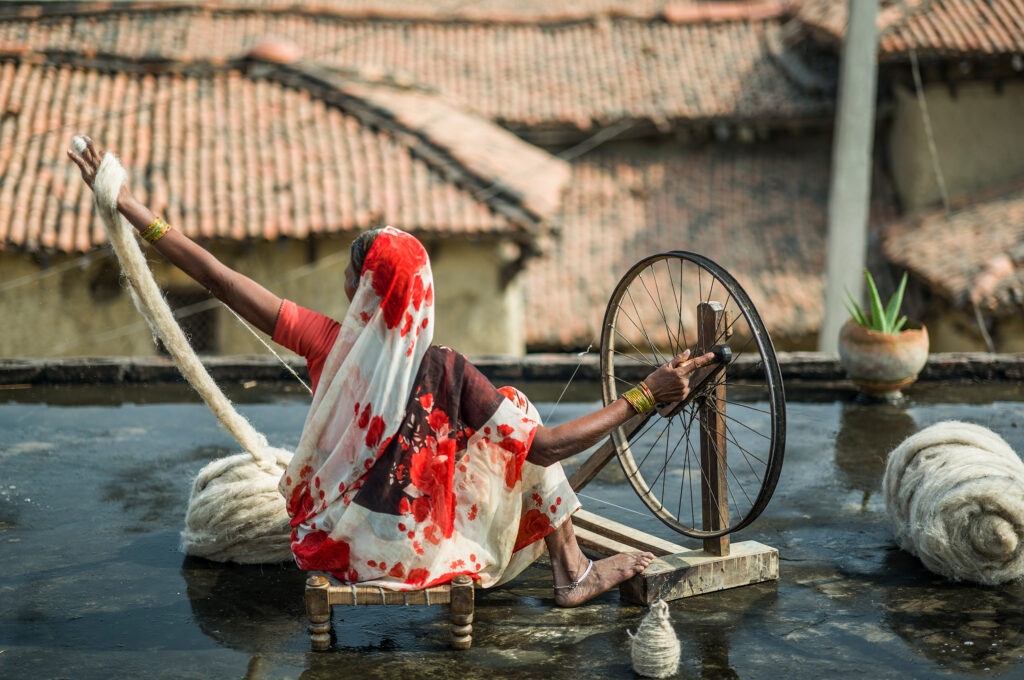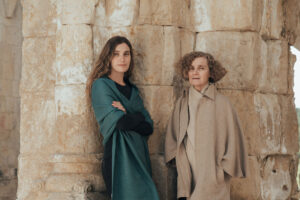
Masaya Co — Sustainable Furniture from Seed to Seat
MasayaCo is a sustainable furniture company on a mission to combat climate change through reforestation & sustainable design.
Australia, USA
Marisa Albanese May 21, 2021
Founded in 2009 by the dynamic duo Jodie Fried and Sally Pottharst, the fair trade and sustainable rug company Armadillo engages a variety of artisan communities throughout India to create their signature designs. Composed of all-natural materials, Armadillo’s rugs combine precision and innovation by incorporating new weaving techniques into each collection while simultaneously supporting traditional craftsmanship. Minimalist yet bold, these rugs perfectly encapsulate the beauty of hand-crafted, sustainable materials, all of which are intended to last a lifetime.
As Australia’s first certified rug B Corporation, Armadillo strives to reduce their impact on the environment. By collaborating with various programs, such as Care & Fair, Armadillo urges others to adopt a more mindful approach to consumerism, as reflected in Fried and Pottharst’s initiative in founding the Armadillo Foundation. Established in 2017, the Armadillo Foundation awards young children from underprivileged communities in India with educational opportunities, with 10% of new profits from each product sold going toward these efforts. Through the Armadillo Foundation, each customer has the ability to contribute to the educational future of young children throughout India. Harnessing a unique richness and creative depth through a myriad of weaving styles, Armadillo remains exemplary not only for their evocative design but for their unwavering commitment to supporting historically marginalized communities across India.
Mood of Living: Where did you grow up?
Jodie Fried : I grew up in Adelaide, Australia and am the eldest of three, with two younger brothers. We had a very simple and free barefoot childhood, spending endless hours on the beach and farms, mostly up trees or in the ocean, with not an adult to be seen! I loved my school years and I was often found spending time in the art or drama classrooms, creating and making things.
Sally Pottharst : I was born in Zimbabwe, in a culture rich in artisans and artistic pursuits. I am the youngest of four children, and I have wonderful memories of family holidays spent in game parks and taking in all the wonderful things the country had to offer.
MoL: Where did you go to college and what did you study? Were you always interested in interior design?
JF: My background is in costume and production design. I studied at the National Institute of Dramatic Art (NIDA) in Sydney, Australia and worked in the arts and entertainment industries, designing costumes and sets for dance, film and theatre. But I have always had an immense appreciation for traditional artisanship and was always entrepreneurial, which is what eventually lured me into the world of interiors and running my own business.
SP: After finishing school, I did a stint teaching art and textile design in Zimbabwe, before moving to South Africa for university and studying a business degree. I then worked as a Chartered Accountant in a large firm for many years after I moved to Australia, but my husband owned a floor covering business in Adelaide, and as I become more involved and more familiar with the interior design market, it then became my main passion.

MoL: What inspired you to create Armadillo? What was your path to starting your own rug company? What or who influenced this direction?
JF: When we met, we really hit it off and were united by our shared passion to create a product we couldn’t find on the market back then – something beautifully enduring and of the most impeccable quality, that would sit in an interior but not steal the show. Our values were also very much aligned. We both come from philanthropic backgrounds, and hence founded Armadillo on the basis of an authentic and unwavering commitment to sustainability and giving back to the community.
MoL: How and when did you join forces to create your brand? Where did the two of you meet and what roles do you both play at your company Armadillo?
SP: We have a seamless working relationship, grounded in the utmost respect and appreciation for each other’s strengths. We still conceive and design every single rug together, but Jodie drives the bigger picture creative direction of the brand – she’s amazing at color palette, scale and the overarching theme of a collection – whereas I love getting into the nitty gritty of the weave and the finishing, and overall am more involved in the financial and operational side of the business.
MoL: How do your combine your passion for artistry, sustainability and social change into your business?
JF: Every Armadillo rug is made by hand, a true celebration of age-old methods of craftsmanship that have been handed down for generations. We only use the finest natural materials, including jute, wool, linen and pure silk, and have partnered with the International Living Future Institute to be as transparent as possible about how our rugs are made and where they go at the end of their lifespan. We are also members of the Care & Fair program, a coalition of businesses committed to fighting illegal child labor and improving living conditions for weavers and their families.
SP: We have also just been certified as a B Corporation, the first Australian rug brand to do so. Sustainability has been at the heart of our business since its inception, so becoming a B Corp was the next step on our journey of ever lightening our footprint on this earth. We see it as a great privilege to have our products in people’s homes and, knowing how hard it is these days for customers to discern whether a brand’s ethical credentials are legitimate, we wanted to hold ourselves up to the highest, third-party verified standards of social and environmental responsibility. Achieving certification is a rigorous process – it’s taken us years and years to get here – and we’re incredibly excited to join a global movement of business as a force for good.
MoL: How does the co-designing process work between the two of you, especially considering the long-distance? How do your current locations and surroundings, Australia and California, influence your design?
SP: Jodie and her family moved to Los Angeles not long after we founded Armadillo, so we’ve never had the luxury of working side by side – or even in the same time zone! After over a decade of fine-tuning our ways of working, we’ve got it down to an art form. We speak multiple times a day and, in a way, because our time together is so precious things come together instantly when we put our heads together. I can’t imagine not having someone else to bounce ideas off.
JF: Our collections have a timeless and worldly feel, very much informed by our love for our natural surroundings as well as our personal travels. It feels exhilarating to immerse myself into a new culture – not just in terms of the sights, sounds and smells but also the light, landscape and architecture – and those sensory experiences inevitably seem to make their way into the hues, textures and compositions of our designs.
MoL: Where do you find design inspiration? How do you balance creating a minimal yet captivating design?
JF: There’s no telling when or where inspiration will strike. Recently, we’ve been falling down a rabbit hole exploring innovative techniques in weaving and knotting that heighten the allure of the natural fiber and bring an almost sculptural feel to the home. There is a lot of play and experimentation involved! I’d say with any design, it comes back to a sense of balance – we might explore richness and depth in hue but keep the composition and embellishment of the rug simpler, or we will keep things tonal but take a rug’s textural intricacy to the extremes.
MoL: All your rugs are crafted using traditional weaving techniques from artisans in India. How do you choose the artisans to collaborate with and how do you balance tradition with contemporary design?
SP: Since our rugs involve a myriad of different styles and techniques, we work with a range of artisans based on their skill set. Different communities are known for their expertise – one might specialize in a flat weave while another will be known for their intricate hand-knots. Although we come to them with ideas, oftentimes the artisans themselves will provide a creative spark – we’ll see something they come up with and be inspired, then push and pull our vision with their technique to land on something new and daring.
MoL: Do your artisans make your rugs using natural fibers and dyes? What is the process of making your rugs including dying, spinning, weaving, washing and finishing?
SP: Our rugs are primarily made of jute and wool, with some linen and silk as well. To us, nothing can replace the beauty of a handmade product. From dyeing to spinning and weaving to finishing, you can see the mark of our makers’ hands in our rugs. To begin, we source the natural materials which are hand-dyed and sun dried for abundant texture and vibrancy. They are then deftly spun, often on hand-powered winders, before making their way to the loom. It’s here, in the weaving and knotting, that you’ll notice that special level of care and precision that a mass-produced item can’t replicate. Gentle washing allows our rugs to shrink just enough to tighten up the weave and ensure maximum durability, before they are finished with handheld scissors in the pursuit of perfection. It’s a process we’ve seen countless times, and yet never ceases to mesmerize.
MoL: Can your customers work with you to create bespoke designs?
JF: We offer a Custom Color program, where customers can customize a rug from our pure wool Agra Collection in a curated palette of 36 nature-inspired hues. As part of the consultation process, they’re invited to share fabric swatches, paint chips and material samples so we can find an exquisite color match that will bring their space to life. For all our rugs, we also offer customization in size and shape – from hallway runners to show-stopping circular rugs. Customers also have the option to tailor their finish with a turnover, hand-binding or tassels.
MoL: How do your collaborations help you to evolve your Fair Trade and sustainable business?
JF: We are continuously working to counteract today’s throwaway culture. Collaborating with like-minded creatives, like our Ellipse Collection with UK-based interior design studio House of Grey, enables us to spread that message far and wide. Our hope is that customers will become more and more mindful about what they bring into their homes, only acquiring what they truly need and which will have longevity in aesthetic and quality.
MoL: What is the Armadillo Foundation and how do you support the legacy and livelihood of traditional artisans? What are the Foundation’s initiatives and what communities benefit? How does the Armadillo Foundation hold true to its motto, “Giving back is the only way forward?”
SP: We established our non-profit organization, the Armadillo Foundation, in 2017 to formalize our philanthropic endeavors. For every rug sold, we donate 10% of net profits towards educational, health care and environmental initiatives, including full funding of the KVM School in India attended by many of our artisans’ children. By bringing an Armadillo rug into your home, you’ll be giving them opportunities they otherwise would not have.
Since 2014, we have fully funded all of KVM’s overheads – everything from staff salaries to school uniforms, textbooks to teaching aids, furniture to utilities, and everything in between. We also sponsor free medical, dental and eye clinics for students and their families. Each year, we also award a nine-year scholarship to the highest performing girls to help them complete their secondary schooling at an English school. As a women-led business, this is the initiative that is probably closest to our hearts.
In the near future, we’re working to expand our scholarship program to other schools and have other initiatives in planning to support local underprivileged communities in Australia and the USA, where our showrooms are based.
MoL: Over the course of the COVID pandemic, many consumers have begun viewing their homes as their oasis. As a result, do you see a shift in consumer interest in home décor and investment?
JF: Absolutely. I think the level of appreciation for our home interiors as a source of nurture and comfort has deepened, while at the same time we’re reflecting on what more we need or want out of each space. We’re demanding more of some rooms – my dining table is working overtime as a place for homework, arts and crafts and, of course, meals – while dedicating other areas like the bedroom as places of refuge. We’re also noticing areas of the home that may have been previously overlooked, which is how our Nook Collection of small space rugs came to fruition late last year.

MoL: Do you lead a conscious lifestyle and if so, how? Have you designed your own living spaces mindfully? What are the steps others can take to create their own mindful living spaces?
JF: Yes, we absolutely lead a conscious lifestyle – especially because my three young children hold us highly accountable! In our recent home build, we considered natural air flow, low VOC paints and other environmentally sustainable building methods. We also designed our spaces to also have less in them, which is a practice in mindfulness in itself. We are minimalists at heart and the things we do have are behind closed doors, so the interior pieces which are in our spaces are considered, meaningful and impactful.
On a domestic level, as a family we compost, recycle, use beeswax sandwich cloths and buy organic produce from our local market with our own bags. If we forget our bags, we fill our pockets and carry the shopping all the way home! The children are like eco-warriors, making sure lights are switched off when not needed and water is not left running when brushing your teeth – it is all those little things that help.
SP: The longer I am alive, the more important I realize how important it is to live consciously. I am passionate about how important it is to take real responsibility for the impact we have in our world. Not only does it give us purpose and satisfaction, our planet needs our help in a big way to protect it, to ensure future generations can enjoy what our incredible planet has to offer. The throwaway culture we live in needs to be halted and we can all take small steps to make our homes more sustainable by investing in furniture and furnishings that have longevity in their aesthetic as well as their quality.
MoL: What advice can you give to people interested in doing something that will impact the world in a positive way?
JF: I think it is important to get involved with your community. Use your power for good – everyone has the power to educate others or influence them to make better decisions. Even changing small things at home is so important when you think about how much landfill we all create every year. Be mindful about your choices, find brands that make a positive impact and invest in purchases that will last.
SP: Do it! Giving back to our world in a positive way, if you are in a position to do so, is so incredibly fulfilling. The benefits gained from helping our planet and all who inhabit it will return rewards in ways you just don’t appreciate until you have given it a go. And it doesn’t need to be a huge undertaking – there are so many ways to get involved to make a positive change.
Photography courtesy of Armadillo and Co

MasayaCo is a sustainable furniture company on a mission to combat climate change through reforestation & sustainable design.

Founder Treana Peake, supports artisan partnerships and funds development work through the Obakki Foundation.

ÁBBATTE creates handmade textiles in Spain on the grounds of a 13th -century Cistercian monastery in the town of Segovia.